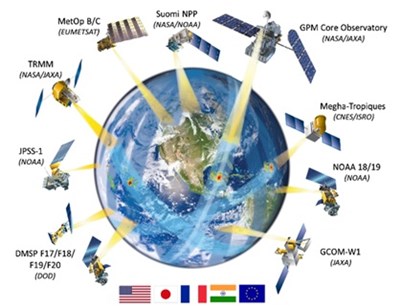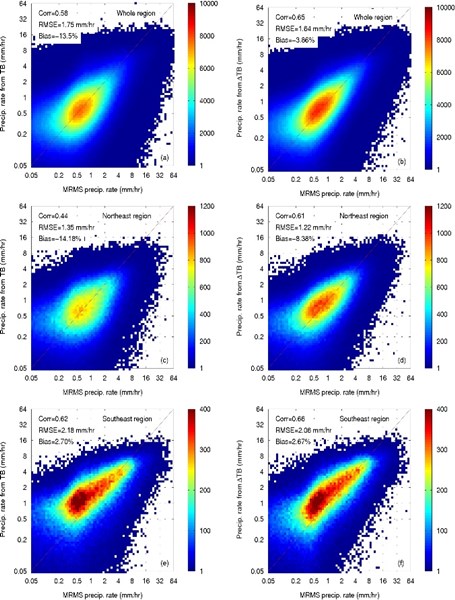Brightness Temperature Temporal Variation and Precipitation Rate
September 11, 2017 08:35 AM

Figure 1: GPM satellite constellation
© NASA-GSFC
CICS-MD Scientist Yalei You (NESDIS/STAR/CRPD/SCSB), who works on the CICS Task "Precipitation Research and Applications," is the first author of a new paper published in the September issue of the Journal of Hydrometeorology. It shows how precipitation rate retrievals can be improved using brightness temperature temporal variation. This study “unifies” the brightness temperature observations from eight polar orbiting satellites, including GPM, F17, F18, SNPP, NOAA-18, NOAA-19, Metop-A, and Metop-B in the GPM satellite constellation. By do so, they were able to estimate precipitation from brightness temperature temporal variation (ΔTB).

Figure 2: (left) Correlation between the instantaneous TB and precipitation rate. (right) Correlation between ΔTB and precipitation rate at the corresponding channel.

Figure 3: (left) Retrieval performance from TBs (V89, …, V190) over CONUS and Northeast region (37-47N, 65-80W). (right) Retrieval performance from ΔTBs (ΔV89, …, ΔV190) over CONUS and Northeast region (37-47N, 65-80W).
Results showed that ΔTB significantly improves the precipitation retrieval in the cold season (e.g., snowfall) and over the complex terrain (e.g., Rocky Mountains). He collaborated on this work with NASA-GSFC scientists Christa Peters-Lidard and Sarah Ringerud, NASA-JPL/Caltech scientist Joseph Turk, and NRL scientist Song Yang. The article has been released on-line: You, Yalei, Christa Peters-Lidard, Joseph Turk, Sarah Ringerud, and Song Yang, 2017: Improving over land precipitation retrieval with brightness temperature temporal variation. J. Hydrometeor., 18, 2355–2383, http://dx.doi.org/doi:10.1175/JHM-D-17-0050.1.
« Back